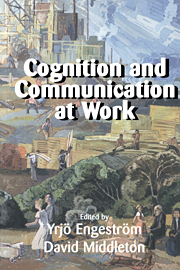Book contents
- Frontmatter
- Contents
- Contributors
- Acknowledgments
- 1 Introduction: Studying work as mindful practice
- 2 Distributed cognition in an airline cockpit
- 3 Constituting shared workspaces
- 4 Seeing as situated activity: Formulating planes
- 5 Convergent activities: Line control and passenger information on the London Underground
- 6 Users and designers in mutual activity: An analysis of cooperative activities in systems design
- 7 System disturbances as springboard for development of operators' expertise
- 8 Expert and novice differences in cognition and activity: A practical work activity
- 9 The tensions of judging: Handling cases of driving under the influence of alcohol in Finland and California
- 10 Talking work: Argument, common knowledge, and improvisation in teamwork
- 11 The collective construction of scientific genius
- 12 Experience and the collective nature of skill
- 13 Working together: Symbolic interactionism, activity theory, and information systems
- 14 On the ethnography of cooperative work
- Index
4 - Seeing as situated activity: Formulating planes
Published online by Cambridge University Press: 05 June 2012
- Frontmatter
- Contents
- Contributors
- Acknowledgments
- 1 Introduction: Studying work as mindful practice
- 2 Distributed cognition in an airline cockpit
- 3 Constituting shared workspaces
- 4 Seeing as situated activity: Formulating planes
- 5 Convergent activities: Line control and passenger information on the London Underground
- 6 Users and designers in mutual activity: An analysis of cooperative activities in systems design
- 7 System disturbances as springboard for development of operators' expertise
- 8 Expert and novice differences in cognition and activity: A practical work activity
- 9 The tensions of judging: Handling cases of driving under the influence of alcohol in Finland and California
- 10 Talking work: Argument, common knowledge, and improvisation in teamwork
- 11 The collective construction of scientific genius
- 12 Experience and the collective nature of skill
- 13 Working together: Symbolic interactionism, activity theory, and information systems
- 14 On the ethnography of cooperative work
- Index
Summary
In order to focus as clearly as possible on some of the issues involved in the analysis of cognition in the workplace, this chapter will investigate a single, very simple, but very pervasive, activity performed by different kinds of workers in a medium-sized airport: looking at airplanes. Despite the brevity of individual glances, they are in no way haphazard. Workers look at planes in order to see something that will help them accomplish the work they are engaged in. Understanding that looking, therefore, requires analysis of the work activities within which it is embedded.
Powerful resources for the detailed analysis of mundane activities have been provided by the approach to the analysis of human interaction that encompasses Goffman (1963, 1971, 1974), Garfinkel (1967), Kendon (1990), and, most relevant to the work in the present paper, conversation analysis (Atkinson & Heritage, 1984; Drew & Heritage, 1992; C. Goodwin, 1981; M. H. Goodwin, in press; Goodwin & Heritage, 1990; Jefferson, 1973, 1984; Sacks, 1992; Sacks, Schegloff, & Jefferson, 1974; Schegloff, 1968). Moreover, in order to see the airplane in an appropriate, task-relevant way, workers use a range of different kinds of tools. A primary perspective for analysis of how human beings interact, not only with other human beings, but also with a material world shaped by the historical activities of others, can be found in activity theory (Cole, 1985, 1990; Engestrom, 1987, 1990; Leont'ev, 1981; Vygotsky, 1962, 1978; Wertsch, 1985) and the work on distributed cognition that grows from it (Hutchins, 1990, 1995; Middleton & Edwards, 1990; Siefert & Hutchins, 1989).
- Type
- Chapter
- Information
- Cognition and Communication at Work , pp. 61 - 95Publisher: Cambridge University PressPrint publication year: 1996
- 234
- Cited by



